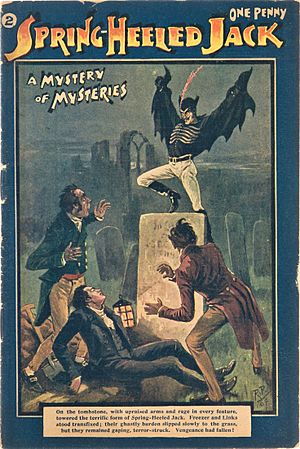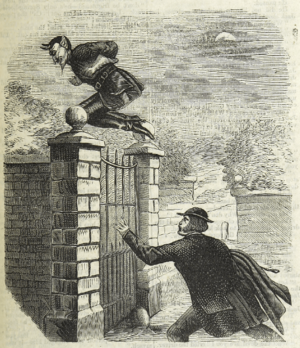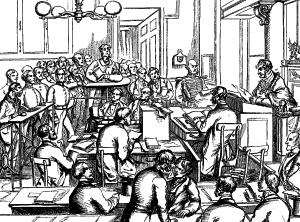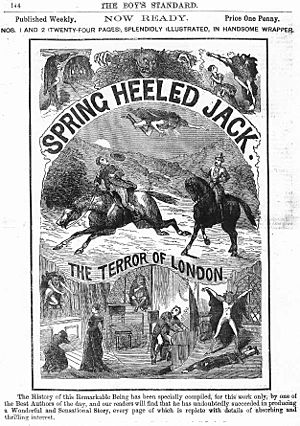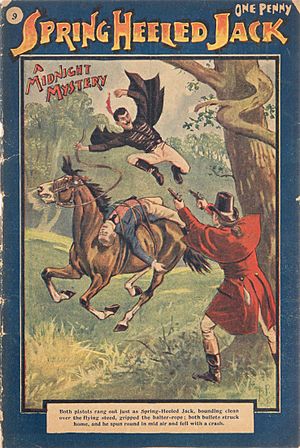Spring-heeled Jack facts for kids
|
Issue 2 cover of 1904 Aldine Spring Heeled Jack Library
|
|
| Grouping | Hoax, mass hysteria, demon, phantom |
|---|---|
| Country | United Kingdom |
| Region | London Liverpool |
Spring-heeled Jack is a mysterious figure from English folklore during the Victorian era. People first claimed to see him in 1837. Later, sightings were reported across the United Kingdom, especially in London, the Midlands, and Scotland.
Many ideas exist about who or what Spring-heeled Jack was. This urban legend became very famous because of his strange look and amazing jumping ability. He even became the subject of many stories and plays.
People who claimed to see Spring-heeled Jack described him as scary and frightening. They said he had a devil-like face, clawed hands, and eyes that looked like "red balls of fire." One person said he wore a helmet and a tight white suit, like a waterproof coat, under a black cloak. Many stories also mentioned he looked like a "Devil." Others said he was tall and thin, like a gentleman. Some reports claimed he could breathe blue and white flames and had sharp metal claws on his fingertips. At least two people said he could speak clear English.
Contents
History of Spring-heeled Jack
Early Ghost Stories
Before Spring-heeled Jack, in the early 1800s, people in London reported seeing ghosts. These figures looked like humans but were pale. People believed they would follow and scare lonely walkers. These ghost stories helped create the later legend of Spring-heeled Jack.
One famous early ghost was the Hammersmith Ghost. It was seen in Hammersmith in 1803, 1804, and again in 1824. Another ghost, the Southampton ghost, was also reported to attack people at night. This spirit had many traits like Spring-heeled Jack. It was said to jump over houses and be over 10 ft (3.0 m) tall.
First Reported Sightings
The first sightings of Spring-heeled Jack were supposedly in London in 1837. The last reported sighting, according to most stories, was in Liverpool in 1904.
One story from October 1837 tells of a girl named Mary Stevens. She was walking home in Battersea when a strange figure jumped at her. He grabbed her and tore her clothes with his claws, which she said felt "cold and clammy." Mary screamed, and the attacker quickly ran away. Neighbors came out to help but could not find him.
The next day, the jumping figure reportedly attacked someone else. He jumped in front of a carriage, causing the coachman to lose control and get hurt. Witnesses said he escaped by jumping over a 9 ft (2.7 m) high wall, laughing with a high-pitched sound.
News of this strange character spread quickly. Soon, newspapers and the public gave him the name "Spring-heeled Jack."
Official Public Concerns
A few months after these first sightings, on January 9, 1838, the Lord Mayor of London, Sir John Cowan, shared a letter he had received. The letter was from "a resident of Peckham" and complained about a group of rich people. It claimed they had made a bet with a friend to scare people while dressed as a ghost, a bear, or a devil. The letter said this person had scared many people, causing them to faint or become very distressed.
The Lord Mayor was a bit doubtful, but someone in the audience confirmed that "servant girls about Kensington, Hammersmith and Ealing, tell dreadful stories of this ghost or devil." The Times newspaper reported this on January 9. The next day, the Lord Mayor showed a large pile of letters from different parts of London. These letters also complained about similar "wicked pranks." Many letters came in, showing that the stories were very common in London's suburbs. One letter said young women in Hammersmith were scared into "dangerous fits" and some were "severely wounded by a sort of claws the miscreant wore on his hands."
The police were told to look for the person responsible, and rewards were offered.
Famous Attacks: Alsop and Scales
Two of the most well-known incidents involving Spring-heeled Jack were the attacks on teenage girls Lucy Scales and Jane Alsop. The Alsop attack was widely reported in newspapers, including The Times. These news stories helped make Spring-heeled Jack even more famous.
The Jane Alsop Case
Jane Alsop said that on the night of February 19, 1838, a man came to her father's door. He claimed to be a police officer and asked her to bring a light, saying, "we have caught Spring-heeled Jack here in the lane." When she handed him the candle, he threw off his cloak. Jane said he looked "hideous and frightful," breathing blue and white flames from his mouth. His eyes looked like "red balls of fire." Miss Alsop also said he wore a large helmet and a tight white suit. He grabbed her and started tearing her dress with his claws, which she believed were "of some metallic substance." She screamed for help and managed to get away. He caught her again on the steps, tearing her neck and arms. Her sister rescued her, and the attacker ran away.
The Lucy Scales Case
Nine days later, on February 28, 1838, 18-year-old Lucy Scales and her sister were walking home. As they passed through Green Dragon Alley, they saw a person in a large cloak. Lucy was walking ahead when the person suddenly shot "a quantity of blue flame" into her face. This made her lose her sight and fall to the ground, having fits for several hours.
Lucy's brother heard screams and found her on the ground. Her other sister explained what happened. She described the attacker as tall, thin, and looking like a gentleman. He wore a large cloak and carried a small lamp. He did not speak or touch them but walked away quickly. Police tried to find the person responsible, questioning several people, but no one was ever charged.
Growing Popularity
After these events, Spring-heeled Jack became one of the most popular figures of his time. His supposed adventures were in newspapers and became the topic of many cheap storybooks called "penny dreadfuls." He also appeared in plays in popular theaters. The devil character in some Punch and Judy puppet shows was even renamed "Spring-heeled Jack."
As his fame grew, reports of Spring-heeled Jack became less frequent but more widespread. In 1843, new sightings appeared across the country. A report from Northamptonshire described him as "the very image of the Devil himself, with horns and eyes of flame." In East Anglia, attacks on mail coach drivers became common. In 1847, a man named Captain Finch was found guilty of attacking women in Teignmouth, Devon, while dressed in a "skin coat, which had the appearance of bullock's hide, skullcap, horns and mask." The legend was also linked to the "Devil's Footprints" seen in Devon in February 1855.
Later Sightings
In the early 1870s, Spring-heeled Jack was reported again in different places. In November 1872, the News of the World newspaper said Peckham was "in a state of commotion" because of the "Peckham Ghost," which was Spring-heeled Jack. Similar stories appeared in The Illustrated Police News. In April and May 1873, many sightings of the "Park Ghost" were reported in Sheffield. Locals also thought this was Spring-heeled Jack.
Aldershot Incidents
More sightings followed, and in August 1877, a notable report came from soldiers in Aldershot Garrison. A sentry on duty saw a strange figure moving towards him. The soldier challenged it, but the figure ignored him. It came close and slapped him several times. A guard shot at the figure, but it seemed to have no effect. Some sources say the soldier might have fired blanks or missed. The strange figure then disappeared into the darkness with "astonishing bounds."
Lord Ernest Hamilton wrote in his 1922 book Forty Years On about Spring-heeled Jack in Aldershot. He said the panic became so great that sentries were given real bullets and told to shoot "the night terror" if they saw it. After this, the sightings stopped. Hamilton believed these were pranks by one of his fellow officers.
Lincolnshire Sightings
In autumn 1877, Spring-heeled Jack was reportedly seen in Lincoln, Lincolnshire, near Newport Arch. He was said to be wearing a sheepskin. An angry crowd supposedly chased and cornered him. Just like in Aldershot, people shot at him, but it had no effect. As usual, he used his amazing jumping skills to escape the crowd and vanish.
Liverpool Sightings
By the late 1800s, reports of Spring-heeled Jack moved to the north-west of England. Around 1888, in Everton, north Liverpool, he supposedly appeared on the roof of Saint Francis Xavier's Church. In 1904, there were reports of him appearing in nearby William Henry Street.
Impact on Popular Culture
The huge urban legend of Spring-heeled Jack influenced many parts of Victorian life, especially popular culture. For decades, especially in London, his name was used like a bogeyman to scare children into behaving. Parents would tell them if they were not good, Spring-heeled Jack would jump up and look into their bedroom windows at night.
However, it was in fictional entertainment that the legend had the biggest impact. Because of his extraordinary nature, he appeared in many stories. He was first shown as a villain but later became a hero. By the early 1900s, he was seen as a costumed hero who helped people and fought against bad guys. He became an early example of pulp fiction and comic book superheroes.
Theories About Spring-heeled Jack
No one was ever caught and identified as Spring-heeled Jack. This, along with his amazing abilities and the long time he was supposedly active, led to many different theories about who or what he was. Some researchers look for normal explanations, while others explore the more fantastic parts of the story, suggesting supernatural ideas.
Skeptical Explanations
Some researchers believe the stories of Spring-heeled Jack were simply mass hysteria. This means many people got scared and believed exaggerated stories about a bogeyman or devil. Or, it could have come from exaggerated stories about a man who climbed over rooftops, claiming the Devil was chasing him.

Other researchers think that one or more people might have started the legend, and then others copied them. Many believed Spring-heeled Jack was not a supernatural creature but one or more people with a strange sense of humor. This idea fits the letter to the Lord Mayor, which blamed a group of young, rich people who made a bet. A popular rumor from 1840 pointed to an Irish nobleman, the Marquess of Waterford, as the main suspect.
The Marquess was often in the news in the late 1830s for fighting, playing rough jokes, and causing damage. He was known to do anything for a bet. His wild behavior and dislike for women earned him the nickname "the Mad Marquis." He was also in London when the first incidents happened. In 1880, E. Cobham Brewer named him as the person responsible. He said the Marquess "used to amuse himself by springing on travellers unawares, to frighten them."
Skeptical researchers say the Spring-heeled Jack story grew and changed due to mass hysteria. Many things could have added to this, such as rumors, superstitions, stories passed down by word of mouth, exciting news reports, and a rich tradition of folklore about fairies and strange creatures. Stories of his jumping and fire-breathing powers, his unusual looks, and his ability to escape captured the public's imagination. This led to a whole urban legend, which was then shown in books and newspapers, making the belief even stronger.
Paranormal Ideas
Many wild and imaginative explanations have been suggested for Spring-heeled Jack. Some think he was an alien with a non-human appearance and special features, like glowing red eyes or fire breath. They suggest his amazing agility came from living on a world with strong gravity. Others believe he was a demon, either accidentally or purposely brought into this world by people practicing occult magic.
Authors who study strange phenomena, like Loren Coleman and Jerome Clark, put "Spring-heeled Jack" in a group called "phantom attackers." Another famous example is the "Mad Gasser of Mattoon." These "phantom attackers" seem human but might have amazing abilities, like Spring-heeled Jack's jumps (which would break a normal human's ankles). They also cannot be caught by authorities. Victims often experience the "attack" in their bedrooms or homes. They might report being held down or unable to move. In some cases, an "attack" is seen by several people and has some physical proof, but the attacker cannot be confirmed to exist.
Similar Figures in Other Cultures
A similar figure known as Pérák, the Spring Man of Prague was reported in Czechoslovakia around 1939–1945. Writers like Mike Dash have shown that Pérák's ability to escape and his supernatural jumping skills are very much like Spring-heeled Jack's. The stories of Pérák show how the traits of Spring-heeled Jack are common in urban folklore around the world. Pérák, like Spring-heeled Jack, became a folk hero. He even starred in animated superhero cartoons, fighting the SS. One of the earliest was Jiří Trnka's 1946 film Pérák a SS or Springman and the SS.
Spring-heeled Jack in Modern Culture
The character of Spring-heeled Jack has been brought back or mentioned in many movies, books, and other media in the 20th and 21st centuries, including:
- Spring-Heeled Jack (1989) – a book by Philip Pullman where Spring-heeled Jack saves orphans from a bad guy.
- The Strange Affair of Spring-Heeled Jack (2010) – a novel by Mark Hodder, showing Spring-heeled Jack as a time traveler.
- The Springheel Saga (2011) – a three-part audio drama by the Wireless Theatre Company.
See also
|


